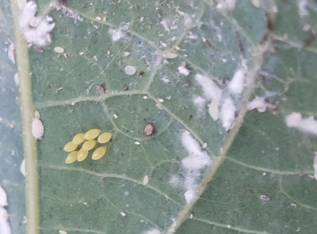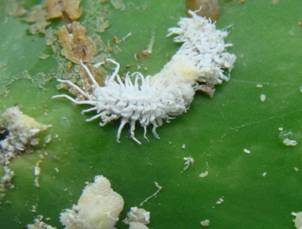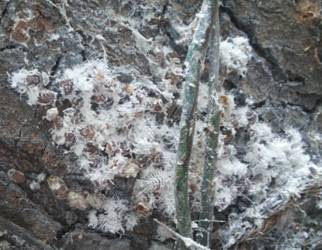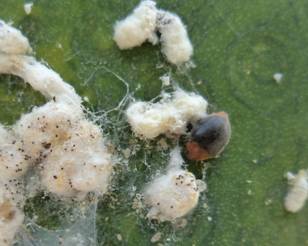Mass production of Cryptolaemus montrouzieri
Introduction
C. montrouzieri has been introduced from Australia for the control of Coccus viridis on coffee. But the predator has established on many species of mealybugs and green shield scale. In the field its practical use for the suppression of mealybugs viz., pink mealy bug, Maconellicoccus hirsutus, citrus mealy bug Planococcus citri, tailed mealy bug Ferrisia virgata and mealy scale Pulvinaria maxima on citrus, coffee, grapes and several other fruit crops and ornamentals has been demonstrated. Use of C. montrouzieri is the break through in applied classical biological control. The coccinellid predator is native of Australia. In 1892, it was introduced into California by Albert Koebele for the control of citrus mealy bugs. Following the success, the beetle was introduced into India in 1898 by New Port. It has given effective control of mealy bugs in fruit crops like citrus, grapes, guava, etc. C. montrouzieri is one of the outstanding examples in the biological control history. Its importance is also evident by its growing commercialization in India.
Production procedures of predator
In the laboratory, the life cycle is completed in approximately 30 days. The premating and preoviposition periods are about 5 and 10 days respectively. The oviposition is about 10 days. Eggs are laid from late evening to early morning. They are pale yellowish white, the surface being smooth and shiny. It is oval to cylindrical, both the ends beings smoothly rounded. Incubation period ranges from 5 to 6 days but extended in winter months. Viability of eggs is 90 to 100 per cent. The newly hatched grub is sluggish but becomes active after 3 to 4 hours. The tiny grub is pale greyish with white lines across the body along intra segmental regions. These white lines become prominent after few hours and white wax strands develop after a day. The grub has four larval instars, and the larval stage occupies about 20 days. They feed on all stages of mealy bugs. Duration of first, second, third and fourth instar grubs are 3-4, 4, 4-5-7-8 days respectively. Grownup grubs are entirely covered with white wax strands. When the grub is disturbed, it exudes a yellow fluid from the dorsal surface of the body for defensive purpose. The prepupal period is 2 to 4 days when it suspends feeding activities. The pupal period varies from 7 to 9 days. The adult spends about one day in the pupal case before it emerges. It is covered with a white powder like substance for a day. The male could be distinguished from the female by the colouration of first pair of legs. The first pair of legs in the case of male is brown and the latter two pairs being black, whereas in the female all the three pairs are black. Male to female ratio is 1 : 1. Adults are also known to attack and feed the mealy bugs. Longevity of adults ranges from 50 to 60 days and the fecundity is about 200-220 eggs.
 |
 |
| Cryptolaemus eggs |
Cryptolaemus nymphs |
 |
 |
| Cryptolaemus pupae |
Cryptolaemus adult |
Feeding behaviour
Both adults and grubs are predating almost all stages of the mealy bug. However the grubs are voracious feeders. The coccinellid grub consumes a total of 900 to 1500 mealy bug eggs in its development. A single grub can eat as many as 30 nymphs or 30 adult mealy bugs. Fourth instar grub is the most voracious feeder of the mealy bugs.
After 15 days of infestation of pumpkins with bugs they are exposed to a set of 100 beetles for 24 hrs. After exposing, the pumpkin is kept back in a cage as described for under production of M. hirsutus. The beetle during the period of exposure feed on mealy bugs as well as deposits their eggs singly or in groups of 4-12. The grubs are visible in such cages within a week of exposure to beetles. The young grubs feed on eggs and small mealy bugs but as they grow they become voracious and feed on all stages of mealy bugs. For facilitating the pupation of grubs dried guava leaves or pieces of papers are kept at the base of each of the cages. The first beetle from the cages starts emerging on 30th day of exposure to C. montrouzieri adults. The beetles are collected daily and kept in separate cages for about 10-15 days to facilitate completion of mating and pre-oviposition. The beetles are also fed on diet containing agar powder (1 g), sugar (20 g), honey (40 cc) and water (100 cc). The adult diet is prepared by boiling sugar in 70 cc of water, adding 1 g agar, diluting 40 cc honey in 30 cc of water and adding to the sugar and agar mixture when it comes to boiling point. The hot liquid diet is kept on small white plastic cards in the form of droplets which get solidified on cooling. Such cards containing adult diet can be fed not only to C. montrouzieri but also to many other species of coccinellids. From each cage about 175 beetles are obtained. The emergence of the beetles is completed within 10 days.
Beetles can also be reared on Corcyra cephalonica eggs but empty ovisacs of Planococcus citri are to be kept for inducing egg laying by the beetles. The beetles are also multiplied on semi synthetic diet which is still in the process of further refinement.
Precautions
All due precautions should be taken to avoid scarcity of food for the grubs to avoid cannibalism by grubs. All the pumpkins showing signs of rotting should be properly incinerated. |




